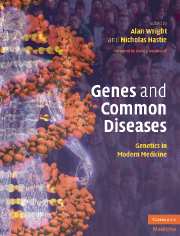Book contents
- Frontmatter
- Contents
- List of Contributors
- Foreword
- Section 1 Introductory Principles
- 1 Genes and their expression
- 2 Epigenetic modification of chromatin
- 3 Population genetics and disease
- 4 Mapping common disease genes
- 5 Population diversity, genomes and disease
- 6 Study design in mapping complex disease traits
- 7 Diseases of protein misfolding
- 8 Aging and disease
- 9 The MHC paradigm: genetic variation and complex disease
- 10 Lessons from single gene disorders
- 11 Environment and disease
- 12 Contemporary ethico-legal issues in genetics
- Section 2 Common Medical Disorders
- Index
- References
9 - The MHC paradigm: genetic variation and complex disease
Published online by Cambridge University Press: 17 August 2009
- Frontmatter
- Contents
- List of Contributors
- Foreword
- Section 1 Introductory Principles
- 1 Genes and their expression
- 2 Epigenetic modification of chromatin
- 3 Population genetics and disease
- 4 Mapping common disease genes
- 5 Population diversity, genomes and disease
- 6 Study design in mapping complex disease traits
- 7 Diseases of protein misfolding
- 8 Aging and disease
- 9 The MHC paradigm: genetic variation and complex disease
- 10 Lessons from single gene disorders
- 11 Environment and disease
- 12 Contemporary ethico-legal issues in genetics
- Section 2 Common Medical Disorders
- Index
- References
Summary
The MHC, the region of the genome widely believed to be associated with disease resistance, is in fact linked with more disease susceptibility than any other region of the human genome (Price et al., 1999). One explanation for this paradox is that there is a net cost in providing resistance to infection. In other words, improved resistance to infection, manifest as a more effective immune response, results in a greater propensity to autoimmune disease. In this article we will explore this proposal by examining the main features of the MHC, the functions of the genes it contains and its role in disease (Lechler and Warrens, 2000; Marsh et al., 2000).
Features of the MHC
The human MHC is a gene-dense region that contains genes for the classical class I molecules HLA -A, -B and -C as well as class II molecules DP, DQ and DR, all of which are highly polymorphic (Figure 9.1). The ∼4Mbp complex is located on chromosome 6p21.3 and contains over 220 genes. The main known function of MHC class I and class II molecules is to present peptide fragments from pathogens on the cell surface for recognition by T cells. This guides killing of virus-infected cells, activation of phagocytes, or production of specific antibodies. Pathogens are known to employ a variety of different strategies in their attempts to evade presentation (Vossen et al., 2002) but features of MHC class I and class II genes help to counteract evasion.
- Type
- Chapter
- Information
- Genes and Common DiseasesGenetics in Modern Medicine, pp. 142 - 151Publisher: Cambridge University PressPrint publication year: 2007



